
Wine Tourism: Hidden Vineyards of South America
South America’s wine country extends far beyond the famous regions of Mendoza and Santiago. Hidden among rolling hills, tucked into remote valleys, and perched on steep mountainsides lie some of the continent’s most extraordinary yet undiscovered wineries. These hidden gems offer wine enthusiasts unique flavors, authentic experiences, and breathtaking landscapes that rival the world’s most celebrated wine destinations.
Uruguay’s Rising Wine Scene
While Argentina and Chile dominate South American wine conversations, Uruguay has quietly emerged as a premium wine destination. The Canelones region, just outside Montevideo, houses boutique wineries producing exceptional Tannat wines. Family-owned establishments like Bodega Garzón have revolutionized the country’s wine industry, combining traditional methods with modern sustainability practices. Their high-altitude vineyards, cooled by Atlantic breezes, produce wines with distinctive character and complexity.
Chile’s Secret Valleys
Beyond the famous Maipo Valley lies Chile’s best-kept secret: the Elqui Valley. This region, known primarily for its astronomical observatories and pisco production, has become an emerging wine destination. Here, vineyards stretch up the mountainsides, reaching elevations of 2,000 meters. The extreme conditions, marked by hot days and cold nights, create unique wines with intense flavors and aromas. Small producers focus on Syrah and Carménère grapes, producing limited quantities of exceptional wines that rarely reach international markets.
Brazil’s Hidden Wine Country
The Serra Gaúcha region in southern Brazil offers a surprising wine experience that blends Brazilian warmth with European heritage. This area, settled by Italian immigrants in the 19th century, maintains strong cultural ties to Italy while developing its own distinctive wine identity. The Vale dos Vinhedos, Brazil’s first wine region to receive Geographical Indication status, produces remarkable sparkling wines that challenge preconceptions about Brazilian viticulture.
Peru’s Sacred Valley Vineyards
While better known for Machu Picchu, Peru’s Sacred Valley harbors small vineyards producing wines at some of the highest altitudes in the world. These vineyards, some reaching heights of 3,000 meters, create unique wines adapted to extreme growing conditions. Local producers often combine ancient agricultural knowledge with modern winemaking techniques, resulting in distinctive wines that tell the story of their extraordinary terroir.
The Art of Wine Tourism
Visiting these hidden vineyards offers more than just wine tasting. Many estates provide immersive experiences including harvest participation, blending workshops, and traditional food pairings. Boutique wineries often offer personalized tours where visitors can speak directly with winemakers and learn about their philosophy and methods. Some estates have developed luxury accommodations, allowing guests to wake up to vineyard views and fully immerse themselves in wine country life.
Sustainable Practices
Many of South America’s hidden wineries lead the way in sustainable viticulture. From organic farming practices to solar-powered facilities, these vineyards demonstrate a commitment to environmental stewardship. Some producers have revived ancient irrigation techniques, while others experiment with drought-resistant varieties, adapting to climate change while preserving traditional winemaking methods.
Cultural Experience
Wine tourism in these regions extends beyond the vineyards. Local communities maintain strong cultural traditions, offering visitors authentic experiences through regional festivals, traditional cuisine, and local artisanal products. Many wineries incorporate indigenous agricultural practices and celebrate local heritage through their wine production and tourism offerings.
Planning Your Visit
The best time to visit these hidden vineyards varies by region. Uruguay’s wine country is ideal during their harvest season (February to March), while Chile’s Elqui Valley offers year-round appeal thanks to its desert climate. Brazil’s Serra Gaúcha shines during the summer harvest festival, though its sparkling wines make it a worthy destination in any season.
Conclusion
South America’s hidden vineyards offer wine enthusiasts an opportunity to explore beyond the beaten path. These lesser-known regions combine exceptional wines with authentic experiences, stunning landscapes, and rich cultural heritage. As wine tourism continues to evolve, these hidden gems provide a glimpse into the future of South American viticulture while honoring its past.

